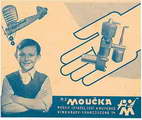Půrok-Bušek 2,0
 |
 |
 |
 |
Click on images to view larger picture.
This engine has been positively identified by Czech Republic model engine expert, Jiri Linka, as a Půrok-Bušek 2,0 made in occupied Czechoslovakia during the period 1941-1942. This makes it one of the very earliest compression ignition engines ("diesels") made outside of Switzerland where the concept is generally accepted to have originated.
The Introduction to Jan Kafka's book, Czech Model Engines, explains that even before World War II, model engines had been very difficult to obtain in the Czech Republic. The very limited number that were available were either self-constructed, or produced as very small production runs by those with access to machinery normally applied to other purposes. One such "manufacturer" was Anton Půrok who made engines at the plant of an aircraft company we believe was called Pragovka and for whom he presumably worked. With a bit of a war on at the time, one imagines that this must have been an "after hours" or lunch-time effort using the company�s equipment, although the hand-filing and fitting could have been done at home.
 Gustav Bušek, a friend of Půrok and associate in the engine making venture since 1939, had somehow got hold of a very early Swiss Dyno, presumably in 1941 when they first came out; how this was managed is not known. It was this engine which gave them the basic idea for making model diesels. The Půrok-Bušek 2,0 (to use the preferred European decimal separator character) was, like the Dyno, of 2cc displacement. Made in batches of 20, it was advertised and sold under the name "Uran" by the Moučka model shop in Prague, thus qualifying as a "production" engine. This advertising placement clearly shows the engine, despite the truncated crankshaft. I'm also a bit concerned about the hair-style on the smiling youth in the picture. Perhaps this was a politically correct thing to do, given the times.
Gustav Bušek, a friend of Půrok and associate in the engine making venture since 1939, had somehow got hold of a very early Swiss Dyno, presumably in 1941 when they first came out; how this was managed is not known. It was this engine which gave them the basic idea for making model diesels. The Půrok-Bušek 2,0 (to use the preferred European decimal separator character) was, like the Dyno, of 2cc displacement. Made in batches of 20, it was advertised and sold under the name "Uran" by the Moučka model shop in Prague, thus qualifying as a "production" engine. This advertising placement clearly shows the engine, despite the truncated crankshaft. I'm also a bit concerned about the hair-style on the smiling youth in the picture. Perhaps this was a politically correct thing to do, given the times.
Making model engines as "foreign orders" in a plant almost certainly producing materiel for the Nazi war effort was a bold move. Still, production continued into 1942. At this time, the country was under the control of SS Obergruppenf�hrer Reinhard Heydrich, aka "the Blond Beast" and "Hangman Heydrich", whom Hitler had appointed Deputy Reich Protector of Bohemia and Moravia in former Czechoslovakia. On May 27, 1942, Czech partisans trained in England mounted an assassination attempt as Heydrich drove an established route in an open top car to his Prague offices. Heydrich was wounded and died on June 4 from blood poisoning brought on by fragments of auto upholstery, steel, and his own uniform that had lodged in his spleen.
Retaliation was swift, extreme, and too violent for repetition here. Tolerance of side-lines like Půrok's engine making would seem to have been another casualty and Půrok kept a low profile until after the war when he turned to full-size soaring. Bušek, on the other hand, went on to become one of the most prolific model engine manufacturers in Czechoslovakia. As manufacturer of the Buš series of engines, Jiri Kalina rates him as a "legendary" Czech engine designer.
 The example at the head of this page was presented as a Watzit from Canadian collector, Adrian Duncan. His engine is close to the examples seen in this 1986 article by Jiri Kalina. The tank is identical, as is the general layout, although there are differences in the location of the join between the crankcase and cylinder jacket and the treatment around the exhaust ports. Our friends in Europe believe it may have been a prototype, or modification to the basic Půrok by Bušek. Regardless, the identification is beyond question and the engine, unique in Jiri's experience, is both historic and somewhere between valuable and priceless.
The example at the head of this page was presented as a Watzit from Canadian collector, Adrian Duncan. His engine is close to the examples seen in this 1986 article by Jiri Kalina. The tank is identical, as is the general layout, although there are differences in the location of the join between the crankcase and cylinder jacket and the treatment around the exhaust ports. Our friends in Europe believe it may have been a prototype, or modification to the basic Půrok by Bušek. Regardless, the identification is beyond question and the engine, unique in Jiri's experience, is both historic and somewhere between valuable and priceless.